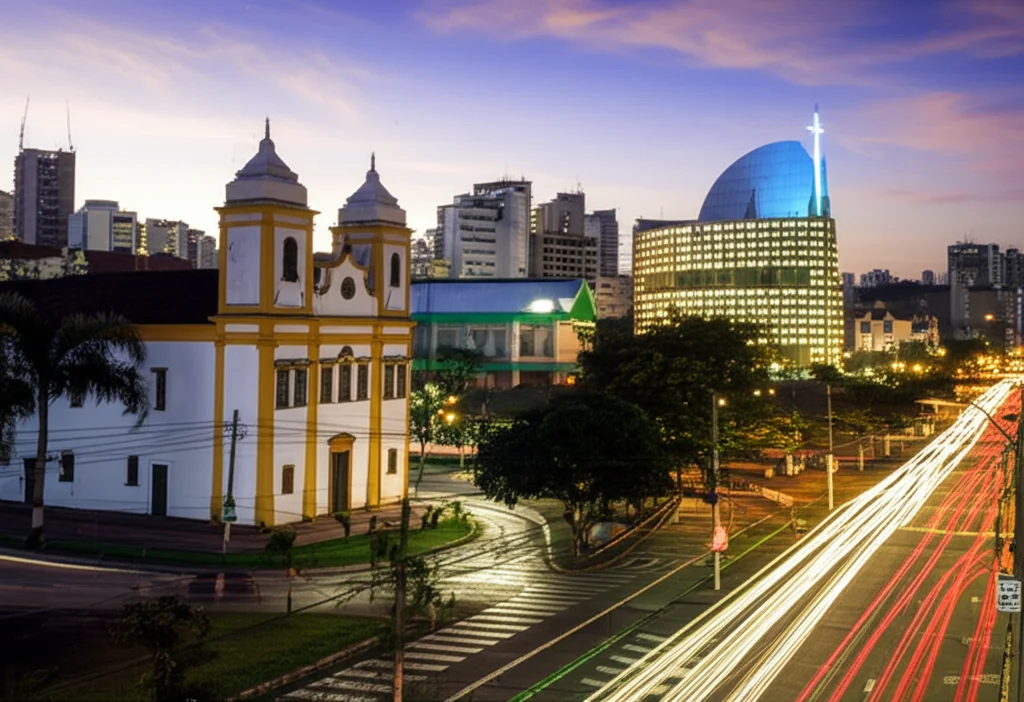Faith, Favela, and a Whole Lotta Flux: Diving into Brazil’s Spiritual Map
Hey there! Ever wondered what makes a place feel the way it does? I’m not just talking about the buildings or the scenery, but the deeper, human stories etched into the very land. Today, we’re diving headfirst into one of the most vibrant and, frankly, mind-boggling spiritual tapestries on Earth: Brazil. This isn’t just about counting churches; it’s about understanding how faith, history, and everyday life mix together to create something truly unique, a process we can call the historicization and humanization of geographical spaces.
Unpacking the Map: How Geographers See Faith
So, how do we even begin to chart something as personal and vast as a nation’s religious soul? Well, some brilliant minds have given us a few compass points. Think of Milton Santos, a giant in geography. He wasn’t just looking at maps; he was looking at how spaces become what they are through time and human action. His ideas about “historicization” – seeing space as a kind of time-space storybook for society – and “humanization” – how we humans actively shape our environments – are super helpful here. Santos saw space not as a static backdrop, but as a dynamic stage where global trends and local lives bump up against each other. It’s like a performance, constantly being rewritten by our actions, our economies, and even our technologies.
Then there’s David E. Sopher, who really helped put “religious geography” on the map, so to speak. He got us thinking about how religious beliefs and practices don’t just float in the air; they take root in actual places. He looked at where religions thrive, how they organize their spaces (think sacred sites, pilgrimage routes), and how different faiths interact. It’s fascinating stuff, especially when you apply it to a place as religiously diverse as Brazil. Sopher’s work reminds us that these landscapes of faith aren’t just pretty postcards; they’re active zones where belief shapes society, and society, in turn, shapes belief.
Brazil’s Ever-Changing Spiritual Canvas
When we zoom in on Brazil, it’s like looking at a kaleidoscope. You’ve got this deep-rooted Catholic history, the explosive growth of Pentecostal churches, vibrant Afro-Brazilian traditions, indigenous spiritualities that have been around for centuries, and even a growing interest in Spiritism and Buddhism. It’s a real mix, and it’s always shifting. This isn’t about religion fading away, as some old theories suggested. Nope, in Brazil, it’s more like faith is constantly reinventing itself, adapting to new challenges and opportunities.
Take Catholicism, for example. Even though its numbers are changing, you can’t miss its mark on Brazil. Those grand churches in city centers, the massive pilgrimage sites like Aparecida – they’re not just buildings; they’re economic engines and cultural anchors. This lines up perfectly with what Santos said about economic and spatial processes being two sides of the same coin. Then you have the rise of Pentecostalism, especially in the urban outskirts. These churches often pop up where people feel left behind, offering not just spiritual comfort but also social support. It’s a powerful example of how religious movements can reshape the urban landscape and create new community hubs.

And it’s not just about physical buildings. What about the “imagined landscapes”? Think about the indigenous quest for the “Land without Evil” – a mythical paradise. This wasn’t a spot on a map, but the idea of it profoundly shaped migration and resistance. Or the Contestado movement, a messianic uprising in early 20th-century Brazil. The people involved weren’t just fighting for land; they were fighting for their vision of a “just land,” a sacred space. These stories show how powerful our inner maps can be, shaping how we interact with the world around us.
From Colonial Imprints to Modern Mosaics
To really get Brazil’s religious geography, we have to rewind a bit. Colonialism left a massive imprint, right? For centuries, the Roman Catholic Church was pretty much the only game in town, thanks to the Padroado system, where the Portuguese crown and the Church were tight. This meant Catholicism shaped not just souls, but also laws, city layouts, and even how people saw nature. But here’s the kicker: forcing a religion on people doesn’t always mean they fully buy into it. Indigenous peoples and African slaves, while officially converting, found incredible ways to keep their own traditions alive, often blending them with Catholic practices. This syncretism is a huge part of Brazil’s spiritual DNA.
Then came the Republic in 1889, and boom – separation of church and state. This opened the doors for religious pluralism. It wasn’t always a smooth ride, but it set the stage for the incredible diversity we see today. The 20th century saw Protestantism, especially Pentecostalism, take off. Afro-Brazilian religions like Candomblé and Umbanda, which had long been practiced, often in secret, gained more visibility. People started moving between faiths, or even identifying with multiple traditions at once. It’s like a spiritual marketplace where individuals craft their own unique paths.

This fluidity is fascinating. You might see someone who was raised Catholic, attends a Pentecostal church, and also respects the practices of Umbanda. It’s less about rigid labels and more about personal experience and connection. Even political figures tap into this. Jair Bolsonaro, for instance, though Catholic, heavily courted the evangelical vote, showing how these religious identities can be pretty flexible and play a big role in public life.
The Human Touch: Faith, Justice, and Everyday Spaces
Milton Santos talked about the “humanization of space,” and that’s exactly what we see in Brazil. Religious groups are constantly shaping and reshaping their environments. Think about the terreiros of Candomblé and Umbanda – these aren’t just buildings; they’re sacred grounds, often in urban neighborhoods or natural settings, where the human and divine meet. Crossroads, beaches, forests – these places take on deep spiritual meaning. Indigenous communities, too, have an incredibly profound connection between their faith, their ancestral lands, and the natural world. For them, religion and geography are inseparable.
But this humanization isn’t always harmonious. Brazil’s history is shot through with social inequality, and religion is right in the middle of it. Jessé Souza, a Brazilian sociologist, talks about how “neo-elites” maintain power and create segregated spaces. This definitely impacts the religious landscape. Sometimes, religious institutions can reinforce these divides. Other times, they become powerful forces for challenging them. Remember Liberation Theology? In the 1980s, Base Ecclesial Communities (CEBs) turned marginalized areas into centers of faith-based activism, fighting for social justice and land rights. That’s faith literally reshaping the land and demanding a more just world.

Even sound plays a role! In some Rio favelas, Christian worship music isn’t just for praise; it’s a way of claiming auditory space, creating a sense of order and safety in areas often marked by insecurity. It’s a reminder that religious presence isn’t just about what you see, but also what you hear and feel.
The Shifting Tides: Evangelicals on the Rise and Digital Faith
One of the biggest stories in Brazil’s recent religious history is the incredible growth of evangelical Christianity. Just a few decades ago, the idea of an evangelical majority seemed far-fetched. Now? It’s a very real possibility. Projections suggest Evangelicals might have even overtaken Catholics in number by 2023. That’s a massive shift! So, what’s driving it?
Several things, really. Urbanization is a big one. As people moved from rural areas to city outskirts, many lost touch with traditional Catholic parishes. Evangelical churches, often more nimble and less bureaucratic, stepped into that gap. They could set up shop quickly, offering accessible places for worship and community, especially where public services were lacking. They became hubs for literacy programs, addiction support, and social help – filling a void left by the state. It’s important to note, though, that a lot of research focuses on urban areas, and we probably need to look more closely at what’s happening in rural religious life too.

And it’s not just a one-way street. Brazilian Protestantism is going global! It’s what some call “reverse flows” – missionaries and migrants are taking their faith to other parts of the world, influencing Christianity far beyond Brazil’s borders.
But here’s a modern twist: what about digital spaces? In our hyper-connected world, faith isn’t just happening in physical buildings. Cristina Rocha’s work on Brazilian Pentecostal youth engaging with global megachurches like Hillsong is super insightful. Through music, streaming, and social media, these young Brazilians are part of a worldwide Christian community. It’s like an “alternative geography of belonging,” blurring the lines between the local and the global, the physical and the virtual. This digital dimension is crucial for understanding how religious identities are being formed and lived out today.
A Never-Ending Story
So, what’s the big takeaway from all this? Brazil’s religious landscape is a living, breathing, constantly evolving thing. It’s a place of incredible dynamism, where ancient traditions meet new movements, where faith shapes cities and forests, and where people craft their own spiritual journeys in deeply personal ways. It’s a testament to how intertwined our beliefs are with the spaces we inhabit and the societies we build.
By looking through the lenses of folks like Milton Santos and David Sopher, we can see that these religious geographies aren’t just backdrops for belief. They are active sites of meaning-making, social struggle, and human creativity. And as Brazil continues to change, you can bet its spiritual map will keep surprising us. It’s a story that’s far from over, and one that tells us a lot about the human need to find meaning and make our mark on the world.

It’s a complex, messy, beautiful picture, and one that reminds us that understanding a place means understanding its soul.
Source: Springer







